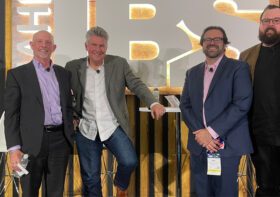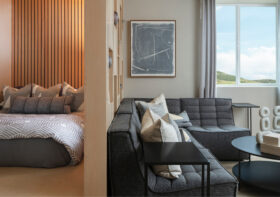Virtual Reality: The Future in the Present

I just graduated college last year. While I did my thesis on psychology and urbanism, another student took on a more robust and relevant topic: virtual reality. His thesis led me to question not just our advisor’s dogma that function follows form, but also the idea of virtual reality (what came first – the VR headset or what’s inside the VR headset?).
So, what is VR, and why is it still so nascent in 2018? After using and exploring VR in school and now, in an architecture firm, here’s what I found:
What is VR?
Virtual reality, or VR, is “the computer-generated simulation of a three-dimensional image or environment that can be interacted with in a seemingly real or physical way by a person using special electronic equipment, such as a helmet with a screen inside or gloves fitted with sensors” (Google Dictionary). There are different ways in which VR photos and videos can be made, but in general, they all involve creating a 360-degree photo or video that aligns with the format of the software the user selects.
If you’ve also heard the term “augmented reality” or AR, don’t get confused – this is different than VR in that AR superimposes a computer simulation into your actual physical environment. VR essentially takes the user to a different world not associated with your actual environment.

Industry Trends in VR
In the architecture industry, VR finds itself useful in two ways: virtual frame-walks and spatial visualizations. Software is available that lets users enter and tour their 3D model; for example, a structural model can be made and architects, builders, engineers, etc. can virtually walk through the space via VR controllers. This allows users to analyze the project before construction even begins, solving possible issues and saving money in construction.
Alternatively, VR can be used to show what the finished product will look like. Prospective buyers can virtually view a home or building with furniture, lighting and materials without ever having to physically be in the space. This offers convenience and is a cheaper and more sustainable option to traditional staging.

The Reality of Virtual Reality
There are two big problems I’ve found with virtual reality so far:
Because you cannot physically see yourself in the virtual environment (i.e., look down and see your feet), you lose a great sense of depth perception. You also cannot feel your surroundings while in VR to understand your distance from one object to the next; because of this, it becomes difficult to accurately design architectural projects in VR. Yet – don’t get me wrong – it is absolutely unbelievable to be in a virtual reality. Half of the time, I find myself reaching out to grab objects that I know I can’t grab, but the quality is so crisp I feel inclined. Technology is being developed that will allow you to feel more present in the space, but for now, VR is a supplement – not a remedy – to designing.
Another problem, though more minor, regards glasses. I have found that it is quite uncomfortable for people (myself included) to wear glasses while using a VR headset. And while this does not apply to every headset, it is apparent that VR headsets were designed first with the non-spectacled person in mind. This will come in time.
The reality is that VR is young. As it continues to develop, so, too, will our architectural designs in a virtual environment.
Despite these problems, I will say the coolest thing about VR is its accessibility. While the best VR viewing is done with high-end headsets and sensors, users can begin to immerse themselves via cardboard – yes, literally cardboard. (Check out some DIYs online to build your own – it’s quite simple and immerses you into the VR community quickly!) The accessibility alone makes VR a great tool and experience for anyone, and I highly recommend to try it out if you haven’t.
The Future of the Present at WHA
As part of WHA’s in-house rendering studio, the VR team is working to create this brand-new service available to clients. On top of our photo-realistic renderings and videos, clients can now request to have their project rendered in 3D for VR-ready viewing. As I said about accessibility, clients can view our VR projects with whatever gear they have available to them – Oculus, Google Cardboard, etc. They can even, simply, view the project on their computer with a mouse and virtually explore the space that way!

We are unveiling our biggest VR project this June at PCBC (the Pacific Coast Builders Conference) in San Francisco, California. Working with Levity, a master-planned community by Cal Atlantic Homes, a Lennar Company, in Tustin, California, we are using VR to immerse users in various places, including the pool area, a 3-story townhome, and a 3-story single-family detached home. Contact us if you would like to check out this amazing experience!




Krish K
Nice post. Very interesting. Keep sharing.